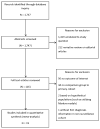The Effect of Endoscopic Surveillance in Patients With Barrett's Esophagus: A Systematic Review and Meta-analysis
- PMID: 29458154
- PMCID: PMC5985204
- DOI: 10.1053/j.gastro.2018.02.022
The Effect of Endoscopic Surveillance in Patients With Barrett's Esophagus: A Systematic Review and Meta-analysis
Abstract
Background & aims: Guidelines recommend endoscopic surveillance of patients with Barrett's esophagus (BE) to identify those with dysplasia (a precursor of carcinoma) or early-stage esophageal adenocarcinoma (EAC) who can be treated endoscopically. However, it is unclear whether surveillance increases survival times of patients with BE. We performed a systematic review and meta-analysis to qualitatively and quantitatively examine evidence for the association of endoscopic surveillance in patients with BE with survival and other outcomes.
Methods: We searched publication databases for studies reporting the effects of endoscopic surveillance on mortality and other EAC-related outcomes. We reviewed randomized controlled trials, case-control studies, studies comparing patients with BE who received regular surveillance with those who did not receive regular surveillance, and studies comparing outcomes of patients with surveillance-detected EAC vs symptom-detected EACs. We performed a meta-analysis of surveillance studies to generate summary estimates using a random effects model. The primary aim was to examine the association of BE surveillance on EAC-related mortality. Secondary aims were to examine the association of BE surveillance with all-cause mortality and EAC stage at time of diagnosis.
Results: A single case-control study did not show any association between surveillance and EAC-related mortality. A meta-analysis of 4 cohort studies found that lower EAC-related and all-cause mortality were associated with regular surveillance (relative risk, 0.60; 95% CI, 0.50-0.71; hazard ratio, 0.75; 95% CI, 0.59-0.94). Meta-analysis of 12 cohort studies showed lower EAC-related and all-cause mortality among patients with surveillance-detected EAC vs symptom-detected EAC (relative risk, 0.73; 95% CI, 0.57-0.94; hazard ratio, 0.59; 95% CI, 0.45-0.76). Lead- and length-time bias adjustment substantially attenuated/eliminated the observed benefits. Surveillance was associated with detection of EAC at earlier stages. A randomized trial is underway to evaluate the effects of endoscopic surveillance on mortality in patients with BE.
Conclusions: In a systematic review and meta-analysis of the effects of surveillance in patients with BE, surveillance as currently performed was associated with detection of earlier-stage EAC and may provide a small survival benefit. However, the effects of confounding biases on these estimates are not fully defined and may completely or partially explain the observed differences between surveyed and unsurveyed patients.
Keywords: Cancer Stage; Lead Time Bias; Length Time Bias; Survival.
Copyright © 2018 AGA Institute. Published by Elsevier Inc. All rights reserved.
Figures






References
-
- Pennathur A, Gibson MK, Jobe BA, et al. Oesophageal carcinoma. Lancet. 2013;381:400–12. - PubMed
-
- Cancer Stat Facts: Esophageal Cancer. NIH SEER Database. 2017
-
- Thrift AP, Whiteman DC. The incidence of esophageal adenocarcinoma continues to rise: analysis of period and birth cohort effects on recent trends. Annals of Oncology. 2012;23:3155–3162. - PubMed
-
- Pohl H, Welch HG. The role of overdiagnosis and reclassification in the marked increase of esophageal adenocarcinoma incidence. J Natl Cancer Inst. 2005;97:142–6. - PubMed
Publication types
MeSH terms
Supplementary concepts
Grants and funding
LinkOut - more resources
Full Text Sources
Other Literature Sources
Medical

